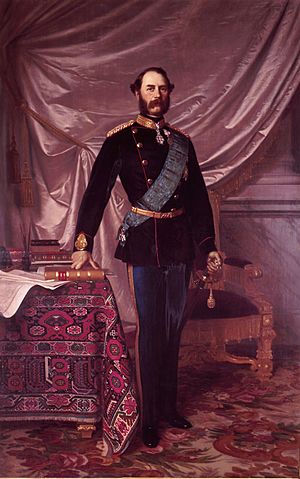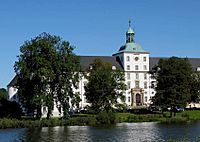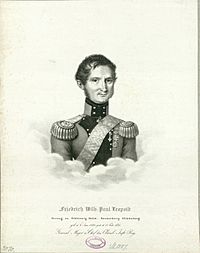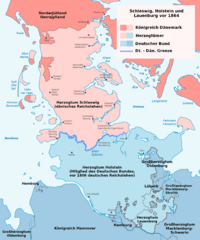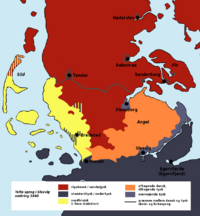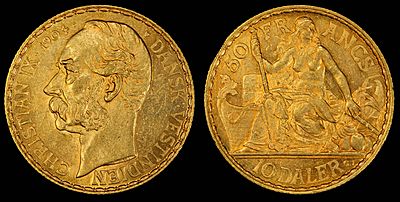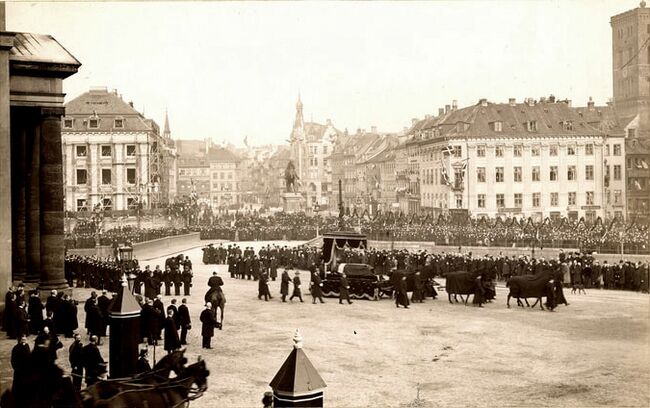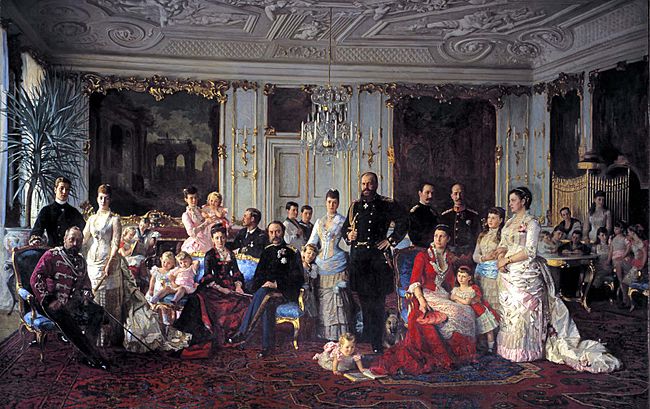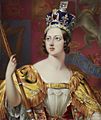Christian IX of Denmark facts for kids
|
||||||||||||||||||||||||||||||||
Christian IX (born 8 April 1818, died 29 January 1906) was the King of Denmark from 1863 until his death. For a short time, he was also the Duke of Schleswig, Holstein, and Lauenburg.
Christian was born a prince of the House of Glücksburg, a smaller branch of the House of Oldenburg. The Oldenburg family had ruled Denmark since 1448. Christian was not originally expected to become king. However, in 1852, he was chosen as the future heir to the Danish throne. This happened because the main royal line was expected to end without children.
When King Frederick VII of Denmark died in 1863, Christian became king. He was the first Danish monarch from the House of Glücksburg. His reign began with a difficult war, the Second Schleswig War. Denmark lost the duchies of Schleswig, Holstein, and Lauenburg. This made the new king very unpopular at first.
Denmark had only become a constitutional monarchy in 1849. This meant the king shared power with a parliament. The early years of Christian's reign were full of arguments about who had more power. Despite his initial unpopularity, Christian's reputation improved over time. He became a national hero because he ruled for a long time and was seen as a very moral person.
In 1842, Christian married his second cousin, Princess Louise of Hesse-Kassel. They had six children who married into royal families all over Europe. This earned Christian the nickname "the father-in-law of Europe". Many of today's European royals are descendants of Christian IX.
Contents
Early Life and Family Background
Christian IX was born on 8 April 1818 at Gottorf Castle in the Duchy of Schleswig. His full name was Prince Christian of Schleswig-Holstein-Sonderburg-Beck. His father was Friedrich Wilhelm, Duke of Schleswig-Holstein-Sonderburg-Glücksburg. His mother was Princess Louise Caroline of Hesse-Kassel. He was named after Prince Christian of Denmark, who later became King Christian VIII. This prince was also his godfather.
Christian's father was the head of the ducal house of Schleswig-Holstein-Sonderburg-Beck. This was a smaller branch of the House of Oldenburg. Through his father, Christian was a direct male descendant of King Christian III of Denmark. This meant he could inherit the duchies of Schleswig-Holstein, but he was not first in line.
Christian's mother was a daughter of Prince Charles of Hesse-Kassel. Prince Charles was a Danish general and governor. Through his mother, Christian was a great-grandson of King Frederick V of Denmark. He was also related to other monarchs, but he had no direct claim to any European throne through her.
Christian lived with his family at Gottorf Castle. In 1825, his father became the Duke of Glücksburg. The family then moved to Glücksburg Castle. Christian grew up there with his siblings. After his father died in 1831, Christian moved to Denmark. He was educated at the Military Academy in Copenhagen.
Marriage and Royal Connections
As a young man, Christian tried to marry his third cousin, Queen Victoria. However, he was not successful. On 26 May 1842, he married his second cousin, Louise of Hesse-Kassel. Their wedding took place at the Amalienborg Palace in Copenhagen. Louise was a niece of King Christian VIII of Denmark.
Becoming Heir to the Throne
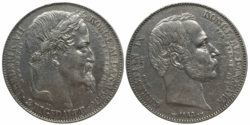
King Frederick VII of Denmark had no children. This caused a big problem for who would become the next king. Denmark followed a rule called Salic Law for succession. This law usually meant only male heirs could inherit. However, the rule was a bit unclear for Denmark's throne.
In 1852, the major European powers agreed on a solution. Christian was chosen as the next in line for the Danish throne. This decision was helped by his marriage to Louise of Hesse-Kassel. Louise was closely related to the Danish royal family.
The decision was made official by the London Protocol on 8 May 1852. Then, the Danish Law of Succession of 1853 confirmed it. This law named Christian as the heir to the entire Danish monarchy. He was also given the title Prince of Denmark.
Understanding the Succession Challenge
| Family of Christian IX of Denmark | |||||||||||||||||||||||||||||||||||||||||||||||||||||||||||||||||||||||||||||||||||||||||||||||||||||||||||||||||||||||||||||||||||||||||||||||||||||||||||||||||||||||||||||||||||||||||||||||||||||||||||||||||||||||||||||||||||||||||||||||||||||||||||||||||||||||||||||||||||||||||||||||||||||||||||||||||||||||||||||||||||||||||||||||||||||||||||||||||||||||||||||||||||||||||||||||||||||||||||||||||||||||||||||||||||||||||||||||||||||||||||||||||||||||||||||||||||||||||||||||||||||||||||||||||||||||||||||||||||||||||||||||||||||||||||||||||||||||||||||||||||||||||||||||||||||||||||||||||||||||||||||||||||||||||||||||||||||||||||||||||||||||||||||||||||||||||||||||||||||||||||||||||||||||||||||||||||||||||||||||||||||||||||||||||||||||||||||||||||||||||||||||||||||||||||||||||||||||||||||||||||||||||||||||||||||||||||||||||||||||||||||||||||||||||||||||||||||||||||||||||||||||||||||||||||||||||||||||||||||||||||||||||||||||||||||||||||||||||||||||||||||||||||||||||||||||||||||||||||||||
|---|---|---|---|---|---|---|---|---|---|---|---|---|---|---|---|---|---|---|---|---|---|---|---|---|---|---|---|---|---|---|---|---|---|---|---|---|---|---|---|---|---|---|---|---|---|---|---|---|---|---|---|---|---|---|---|---|---|---|---|---|---|---|---|---|---|---|---|---|---|---|---|---|---|---|---|---|---|---|---|---|---|---|---|---|---|---|---|---|---|---|---|---|---|---|---|---|---|---|---|---|---|---|---|---|---|---|---|---|---|---|---|---|---|---|---|---|---|---|---|---|---|---|---|---|---|---|---|---|---|---|---|---|---|---|---|---|---|---|---|---|---|---|---|---|---|---|---|---|---|---|---|---|---|---|---|---|---|---|---|---|---|---|---|---|---|---|---|---|---|---|---|---|---|---|---|---|---|---|---|---|---|---|---|---|---|---|---|---|---|---|---|---|---|---|---|---|---|---|---|---|---|---|---|---|---|---|---|---|---|---|---|---|---|---|---|---|---|---|---|---|---|---|---|---|---|---|---|---|---|---|---|---|---|---|---|---|---|---|---|---|---|---|---|---|---|---|---|---|---|---|---|---|---|---|---|---|---|---|---|---|---|---|---|---|---|---|---|---|---|---|---|---|---|---|---|---|---|---|---|---|---|---|---|---|---|---|---|---|---|---|---|---|---|---|---|---|---|---|---|---|---|---|---|---|---|---|---|---|---|---|---|---|---|---|---|---|---|---|---|---|---|---|---|---|---|---|---|---|---|---|---|---|---|---|---|---|---|---|---|---|---|---|---|---|---|---|---|---|---|---|---|---|---|---|---|---|---|---|---|---|---|---|---|---|---|---|---|---|---|---|---|---|---|---|---|---|---|---|---|---|---|---|---|---|---|---|---|---|---|---|---|---|---|---|---|---|---|---|---|---|---|---|---|---|---|---|---|---|---|---|---|---|---|---|---|---|---|---|---|---|---|---|---|---|---|---|---|---|---|---|---|---|---|---|---|---|---|---|---|---|---|---|---|---|---|---|---|---|---|---|---|---|---|---|---|---|---|---|---|---|---|---|---|---|---|---|---|---|---|---|---|---|---|---|---|---|---|---|---|---|---|---|---|---|---|---|---|---|---|---|---|---|---|---|---|---|---|---|---|---|---|---|---|---|---|---|---|---|---|---|---|---|---|---|---|---|---|---|---|---|---|---|---|---|---|---|---|---|---|---|---|---|---|---|---|---|---|---|---|---|---|---|---|---|---|---|---|---|---|---|---|---|---|---|---|---|---|---|---|---|---|---|---|---|---|---|---|---|---|---|---|---|---|---|---|---|---|---|---|---|---|---|---|---|---|---|---|---|---|---|---|---|---|---|---|---|---|---|---|---|---|---|---|---|---|---|---|---|---|---|---|---|---|---|---|---|---|---|---|---|---|---|---|---|---|---|---|---|---|---|---|---|---|---|---|---|---|---|---|---|---|---|---|---|---|---|---|---|---|---|---|---|---|---|---|---|---|---|---|---|---|---|---|---|---|---|---|---|---|---|---|---|---|---|---|---|---|---|---|---|---|---|---|---|---|---|---|---|---|---|---|---|---|---|---|---|---|---|---|---|---|---|---|---|---|---|---|---|---|---|---|---|---|---|---|---|---|---|---|---|---|---|---|---|---|---|---|---|---|---|---|---|---|---|---|---|---|---|---|---|---|---|---|---|---|---|---|---|---|---|---|---|---|---|---|---|---|---|---|---|---|---|---|---|---|---|---|---|---|---|---|---|---|---|---|---|---|---|---|---|---|---|---|---|---|---|---|---|---|---|---|---|---|---|---|---|---|---|---|---|---|---|---|---|---|---|---|---|---|---|---|---|---|---|---|---|---|---|---|---|---|---|---|---|---|---|---|---|---|---|---|---|---|---|---|---|---|---|---|---|---|---|---|---|---|---|---|---|---|---|---|---|---|---|---|---|---|---|---|---|---|---|---|---|---|---|---|---|---|---|---|---|---|---|---|---|---|---|---|---|---|---|---|---|---|---|---|---|---|---|---|---|---|---|---|---|---|---|---|---|---|---|---|---|---|---|---|---|---|---|---|---|---|---|---|---|---|---|---|---|---|---|---|---|---|---|---|---|---|---|---|---|---|---|---|---|---|---|---|---|---|---|---|---|---|---|---|---|---|---|---|---|---|---|---|---|---|---|---|---|---|---|---|---|---|---|---|---|---|---|---|---|---|---|---|---|---|---|---|---|---|---|---|---|---|---|---|---|---|---|---|---|---|---|---|---|---|---|---|
|
|||||||||||||||||||||||||||||||||||||||||||||||||||||||||||||||||||||||||||||||||||||||||||||||||||||||||||||||||||||||||||||||||||||||||||||||||||||||||||||||||||||||||||||||||||||||||||||||||||||||||||||||||||||||||||||||||||||||||||||||||||||||||||||||||||||||||||||||||||||||||||||||||||||||||||||||||||||||||||||||||||||||||||||||||||||||||||||||||||||||||||||||||||||||||||||||||||||||||||||||||||||||||||||||||||||||||||||||||||||||||||||||||||||||||||||||||||||||||||||||||||||||||||||||||||||||||||||||||||||||||||||||||||||||||||||||||||||||||||||||||||||||||||||||||||||||||||||||||||||||||||||||||||||||||||||||||||||||||||||||||||||||||||||||||||||||||||||||||||||||||||||||||||||||||||||||||||||||||||||||||||||||||||||||||||||||||||||||||||||||||||||||||||||||||||||||||||||||||||||||||||||||||||||||||||||||||||||||||||||||||||||||||||||||||||||||||||||||||||||||||||||||||||||||||||||||||||||||||||||||||||||||||||||||||||||||||||||||||||||||||||||||||||||||||||||||||||||||||||||||
The problem of who would inherit the Danish throne was very complicated. Denmark followed a rule that mostly allowed male heirs to inherit. However, the main royal line was about to end with King Frederick VII, who had no children. This meant the rules for succession were not entirely clear.
Many royal families across Europe were related to the Danish throne. They all had different claims. For example, Frederick, Duke of Schleswig-Holstein-Sonderburg-Augustenburg, claimed the duchies of Schleswig and Holstein. But his father had given up his claims for money.
Christian was a good choice for king from Denmark's point of view. He was a distant relative of the royal family. He had grown up in Denmark and was seen as a Dane, not a German nationalist. He was also eligible to inherit Schleswig-Holstein, though not first in line.
In 1842, Christian married Princess Louise of Hesse-Kassel. Louise's mother and siblings gave up their rights to the throne in favor of Louise and Christian. This made Christian's wife the closest female heir to Frederick VII.
Becoming King and the Second Schleswig War
When King Frederick VII died on 15 November 1863, Christian became King Christian IX. Denmark immediately faced a big problem over Schleswig and Holstein. These were two provinces south of Denmark. In November 1863, Frederick of Augustenburg claimed these duchies for himself.
Under pressure, Christian signed a new constitution. This treaty made Schleswig part of Denmark. This led to the Second Schleswig War in 1864. Denmark fought against an alliance of Prussia and Austria. Denmark lost the war, and Schleswig became part of Prussia. Holstein became part of Austria, and later also Prussia.
After this defeat, Christian IX secretly tried to contact the Prussians. He offered for all of Denmark to join the German Confederation. This was if Denmark could keep Schleswig and Holstein. But Otto von Bismarck, the Prussian leader, refused. He worried about conflicts between Danes and Germans in Schleswig. These secret talks were not known to the public until 2010.
Christian IX's Reign
The loss in the 1864 war affected Christian IX's rule for many years. People unfairly blamed him for the defeat. His popularity suffered even more because he tried to stop democracy from spreading in Denmark. He supported a very strict prime minister named Estrup. Many people saw Estrup's rule (1875–1894) as a kind of dictatorship.
However, Christian IX did sign a treaty in 1874. This allowed Iceland, which was then Danish, to have its own constitution. In 1901, he reluctantly asked Johan Henrik Deuntzer to form a new government. This was the first Danish government that did not include the conservative party. This marked the beginning of parliamentarism in Denmark. This change greatly improved Christian's reputation in his final years.
Another important change happened in 1866. The Danish constitution was updated. This gave more power to the upper house of parliament. Social security also improved during his reign. Pensions for old age were started in 1891. Unemployment and family benefits were introduced in 1892.
Death and Legacy
Queen Louise died on 29 September 1898. Christian IX died peacefully of old age on 29 January 1906. He was 87 years old and had reigned for 42 years. He passed away at the Amalienborg Palace in Copenhagen.
After a public viewing at the Christiansborg Palace Chapel, he was buried next to Queen Louise. They rest in Christian IX's Chapel in Roskilde Cathedral. This cathedral is the traditional burial place for Danish monarchs. After Christian IX's death, his son, Crown Prince Frederick, became King Frederick VIII of Denmark.
The "Father-in-Law of Europe"
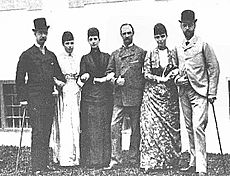
Christian's many family connections to Europe's royal families earned him the nickname "the father-in-law of Europe". Four of his children became monarchs or royal consorts. They ruled in Denmark, Greece, the United Kingdom, and Russia. His youngest son, Valdemar, was even chosen to be Prince of Bulgaria. However, Christian IX did not allow him to accept this role.
The great success of his children's marriages was largely due to his wife, Louise of Hesse-Kassel. Another reason was that Denmark was not a "Great Power." This meant other countries did not worry that Danish royal marriages would upset the balance of power in Europe.
Christian's grandsons included Nicholas II of Russia, Constantine I of Greece, George V of the United Kingdom, Christian X of Denmark, and Haakon VII of Norway.
Today, many of Europe's current and former royal families are direct descendants of Christian IX. This includes Queen Margrethe II of Denmark, King Philippe of Belgium, King Harald V of Norway, King Felipe VI of Spain, and Grand Duke Henri of Luxembourg.
Honours and Recognition
King Christian IX Land in Greenland is named after him.
National orders and decorations
- Grand Cross of the Dannebrog, 28 June 1840; Grand Commander in Diamonds, 15 November 1863
- Knight of the Elephant, 22 June 1843
- Cross of Honour of the Order of the Dannebrog
Foreign orders and decorations
 Ascanian duchies: Grand Cross of Albert the Bear, 18 January 1854
Ascanian duchies: Grand Cross of Albert the Bear, 18 January 1854 Austria-Hungary: Grand Cross of St. Stephen, 1867
Austria-Hungary: Grand Cross of St. Stephen, 1867 Baden:
Baden:
- Knight of the House Order of Fidelity, 1877
- Knight of the Order of Berthold the First, 1877
 Kingdom of Bavaria: Knight of St. Hubert, 1888
Kingdom of Bavaria: Knight of St. Hubert, 1888 Belgium: Grand Cordon of the Order of Leopold, 10 September 1862
Belgium: Grand Cordon of the Order of Leopold, 10 September 1862 Empire of Brazil: Grand Cross of the Order of Pedro I
Empire of Brazil: Grand Cross of the Order of Pedro I

 Ernestine duchies: Grand Cross of the Saxe-Ernestine House Order, October 1838
Ernestine duchies: Grand Cross of the Saxe-Ernestine House Order, October 1838 French Empire: Grand Cross of the Legion of Honour
French Empire: Grand Cross of the Legion of Honour Kingdom of Greece: Grand Cross of the Redeemer
Kingdom of Greece: Grand Cross of the Redeemer Kingdom of Hawaii: Grand Cross of the Order of Kamehameha I
Kingdom of Hawaii: Grand Cross of the Order of Kamehameha I Electorate of Hesse: Grand Cross of the Golden Lion, 22 September 1842
Electorate of Hesse: Grand Cross of the Golden Lion, 22 September 1842 Grand Duchy of Hesse: Grand Cross of the Ludwig Order, 1 October 1863
Grand Duchy of Hesse: Grand Cross of the Ludwig Order, 1 October 1863 Kingdom of Italy: Knight of the Annunciation, 9 November 1864
Kingdom of Italy: Knight of the Annunciation, 9 November 1864 Empire of Japan: Grand Cordon of the Order of the Chrysanthemum, 24 September 1886
Empire of Japan: Grand Cordon of the Order of the Chrysanthemum, 24 September 1886 Mecklenburg: Grand Cross of the Wendish Crown, with Crown in Ore, 1872
Mecklenburg: Grand Cross of the Wendish Crown, with Crown in Ore, 1872 Mexican Empire: Grand Cross of the Mexican Eagle, with Collar, 1865
Mexican Empire: Grand Cross of the Mexican Eagle, with Collar, 1865 Monaco: Grand Cross of St. Charles
Monaco: Grand Cross of St. Charles Principality of Montenegro: Grand Cross of the Order of Prince Danilo I
Principality of Montenegro: Grand Cross of the Order of Prince Danilo I Nassau: Knight of the Gold Lion of Nassau, September 1859
Nassau: Knight of the Gold Lion of Nassau, September 1859 Netherlands: Grand Cross of the Netherlands Lion
Netherlands: Grand Cross of the Netherlands Lion Ottoman Empire: Yüksek İmtiyaz Nişanı in Diamonds, 1885
Ottoman Empire: Yüksek İmtiyaz Nişanı in Diamonds, 1885 Beylik of Tunis: Husainid Family Order, in Diamonds
Beylik of Tunis: Husainid Family Order, in Diamonds Kingdom of Portugal:
Kingdom of Portugal:
- Grand Cross of the Military Order of Christ
- Grand Cross of the Tower and Sword
- Grand Cross of the Immaculate Conception of Vila Viçosa
 Kingdom of Prussia:
Kingdom of Prussia:
- Knight of the Black Eagle, with Collar
- Grand Cross of the Red Eagle
 United Principalities of Romania: Grand Cross of the Star of Romania
United Principalities of Romania: Grand Cross of the Star of Romania Russian Empire:
Russian Empire:
- Knight of St. Andrew
- Knight of St. Alexander Nevsky
- Knight of the White Eagle
- Knight of St. Anna, 1st Class
- Knight of St. Stanislaus, 1st Class
 Saxe-Weimar-Eisenach: Grand Cross of the White Falcon, 1878
Saxe-Weimar-Eisenach: Grand Cross of the White Falcon, 1878 Kingdom of Saxony: Knight of the Rue Crown
Kingdom of Saxony: Knight of the Rue Crown Principality of Serbia: Grand Cross of the Cross of Takovo
Principality of Serbia: Grand Cross of the Cross of Takovo Siam: Grand Cross of the White Elephant
Siam: Grand Cross of the White Elephant Spain: Knight of the Golden Fleece, 22 March 1864
Spain: Knight of the Golden Fleece, 22 March 1864
 Sweden-Norway:
Sweden-Norway:
- Knight of the Seraphim, with Collar, 8 June 1848
- Grand Cross of St. Olav, 29 July 1869
- Knight of the Norwegian Lion, 10 September 1904
 United Kingdom:
United Kingdom:
- Honorary Grand Cross of the Bath (civil), 20 March 1863
- Knight of the Garter, 17 June 1865
- Royal Victorian Chain, 8 April 1904
 Württemberg: Grand Cross of the Württemberg Crown, 1888
Württemberg: Grand Cross of the Württemberg Crown, 1888
Honorary military appointments
- Honorary General of the Swedish Army, 1872 (Sweden-Norway)
Issue
| Name | Birth | Death | Spouse | Children |
|---|---|---|---|---|
| Frederick VIII of Denmark | 3 June 1843 | 14 May 1912 | Princess Louise of Sweden | Christian X of Denmark Haakon VII of Norway Louise, Princess Frederick of Schaumburg-Lippe Prince Harald of Denmark Princess Ingeborg, Duchess of Västergötland Princess Thyra of Denmark Prince Gustav of Denmark Princess Dagmar, Mrs. Castenskiold |
| Princess Alexandra of Denmark | 1 December 1844 | 20 November 1925 | Edward VII of the United Kingdom | Prince Albert Victor, Duke of Clarence and Avondale George V of the United Kingdom Louise, Princess Royal and Duchess of Fife Princess Victoria of the United Kingdom Maud, Queen of Norway Prince Alexander John of Wales |
| George I of Greece | 24 December 1845 | 18 March 1913 | Grand Duchess Olga Constantinovna of Russia | Constantine I of Greece Prince George of Greece and Denmark Grand Duchess Alexandra Georgievna of Russia Prince Nicholas of Greece and Denmark Grand Duchess Maria Georgievna of Russia Princess Olga of Greece and Denmark Prince Andrew of Greece and Denmark Prince Christopher of Greece and Denmark |
| Princess Dagmar of Denmark | 26 November 1847 | 13 October 1928 | Alexander III of Russia | Nicholas II of Russia Grand Duke Alexander Alexandrovich of Russia Grand Duke George Alexandrovich of Russia Grand Duchess Xenia Alexandrovna of Russia Grand Duke Michael Alexandrovich of Russia Olga Alexandrovna, Duchess Peter Alexandrovich of Oldenburg |
| Princess Thyra of Denmark | 29 September 1853 | 26 February 1933 | Ernest Augustus, Crown Prince of Hanover and Duke of Cumberland and Teviotdale | Marie Louise, Margravine of Baden George William, Hereditary Prince of Hanover Alexandra, Grand Duchess of Mecklenburg-Schwerin Princess Olga of Hanover and Cumberland Prince Christian of Hanover and Cumberland Ernest Augustus, Prince of Hanover and Duke of Brunswick |
| Prince Valdemar of Denmark | 27 October 1858 | 14 January 1939 | Princess Marie of Orléans | Prince Aage, Count of Rosenborg Prince Axel of Denmark Prince Erik, Count of Rosenborg Prince Viggo, Count of Rosenborg Margaret, Princess René of Bourbon-Parma |
Images for kids
-
Prince Christian's childhood home, Glücksburg Castle in Schleswig-Holstein.
-
Prince Christian's foster father, Frederick VI of Denmark.
-
Prince Christian's first marriage prospect, Queen Victoria.
-
Princess Louise's uncle, Christian VIII of Denmark.
-
Bernstorff Palace, Prince Christian's summer home as heir (2006).
-
A 2 rigsdaler coin showing the death of Frederik VII and the start of Christian IX's reign.
-
Cenotaph of King Christian IX and Queen Louise in Roskilde Cathedral.
See also
 In Spanish: Cristián IX de Dinamarca para niños
In Spanish: Cristián IX de Dinamarca para niños


